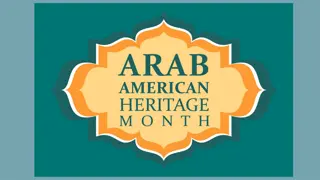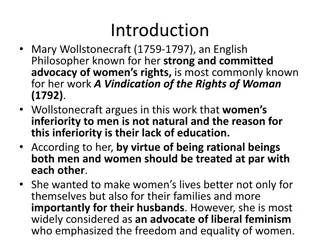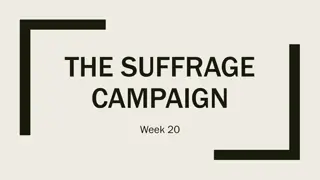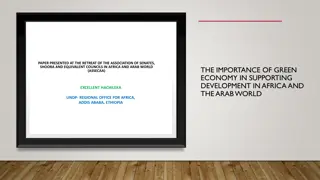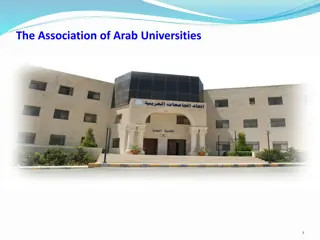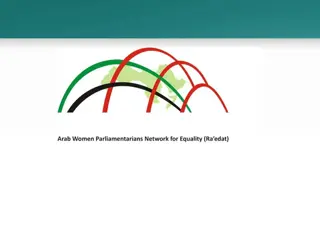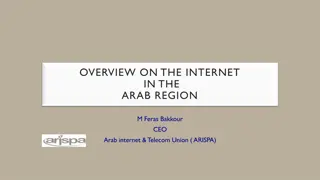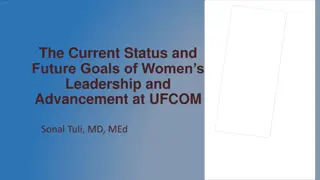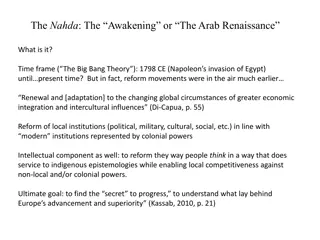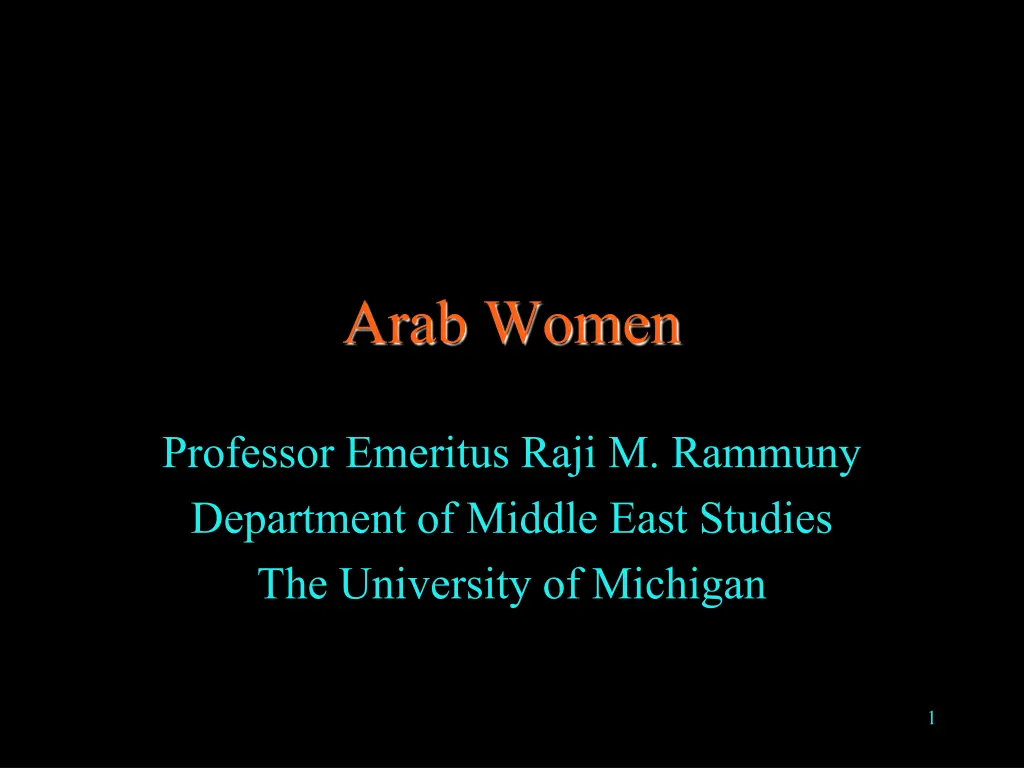
Understanding the Status of Arab Women in Society Today
Explore the status of Arab women within society, touching on topics such as women's studies, cultural expectations, the role of Islam, and the challenges and accomplishments faced by Arab women. Learn about the importance of recognizing the contributions of women and the evolving roles and needs of Arab women in contemporary society.
Download Presentation

Please find below an Image/Link to download the presentation.
The content on the website is provided AS IS for your information and personal use only. It may not be sold, licensed, or shared on other websites without obtaining consent from the author. If you encounter any issues during the download, it is possible that the publisher has removed the file from their server.
You are allowed to download the files provided on this website for personal or commercial use, subject to the condition that they are used lawfully. All files are the property of their respective owners.
The content on the website is provided AS IS for your information and personal use only. It may not be sold, licensed, or shared on other websites without obtaining consent from the author.
E N D
Presentation Transcript
Arab Women Professor Emeritus Raji M. Rammuny Department of Middle East Studies The University of Michigan 1
Pre-Listening Questions 1. To what extent is it possible to discuss the status of women in isolation from the broader context of society in general? What are the advantages to such an approach? What are the disadvantages? 2. How would you describe the status of women in US society? How does this differ from the situation of 25 years ago? How would you describe the process by which this change occurred? 3. In what ways has the feminist movement in the US been successful? In what ways has it been less than successful? 4. What are some of the popular images of Arab women? How accurate do you think these are? 5. Take a few minutes to jot down a couple of sentences describing your perception of the status of women in the Arab world. 2
Arab Women 1. Women s Studies 2. Status of Arab Women 3. Changing Roles and Needs 4. Culturally Relevant Response 5. The Future 3
1. Womens Studies Until recently, the feminine perspective as a full half of human society has been ignored. The need to recognize the contributions by women led to the addition of women s studies program s in many colleges and universities. 4
2. Status of Arab Women Arab society has specific expectations of its members; rights and responsibilities are determined by gender to a very large extent. This ensures that each individual in the society or family knows what role is expected of him or her in maintaining the collective good. 5
a. Ensuring that the welfare of the family is provided for The family, as we know, is the most important institution of Arab society. Arab women, as mothers, provide the heart and foundation of that vital institution. Arab society recognizes the importance of women in this regard. A well-known Arabic proverb tells us that al-janna taHta aqdaam al-ummahaat, or Paradise is at the feet of women. 6
b. Role of Islam Islamic family law influences women s position in almost all aspects of their lives: work, marriage, divorce, social behavior, inheritance, and education. And since Arabs and Muslims are diverse, they differ greatly in the application and interpretation of the law from one country to another. Women s rights and responsibilities are equal to those of men but not identical. Equality and identity are two different things. The Qur an says that man and woman are a garment for each other, which symbolizes this mutual interdependence. 7
b. Role of Islam Women s roles are considered complementary, not competitive, with men s. However, there is a separate legal status for women (property, earnings, and name). From the beginning of Islam, women have been granted full legal rights. A woman can keep her full name forever, even after marriage. Also, she must give her consent for anything that involves a transaction. The marriage contract, for example, requires that the man and the woman agree in total freedom to marry each other. 8
c. Agriculture Rural women play a large part in the total agricultural process: planting, harvesting, tending cattle, collecting water and fuel, cooking. In rural areas, women have to help their husbands to provide sustenance for the family. 9
c. Industry/education A small percentage work in industry. The majority work in the public sector (schools, hospitals, government officials). 10
c. Industry/education Women usually take jobs in industry in order to maintain a reasonable standard of living for the family. The Industrial Revolution, aided by writers unions and national liberation movements, calls for women s contribution to the work force. 11
3. Changing Roles and Needs Women s responsibilities have increased in the last quarter century as a result of men s moving to urban areas or to oil-producing countries to work in industry. This opened up new opportunities for women to enter the industrial labor force, as replacements for men. Over the past two decades, Islamic family law has been undergoing considerable changes, affecting marriage, divorce, polygamy, child custody rights, and gender relations. Women today can sue for divorce and child custody in a number of countries. 12
Queen Rania of Jordan on Arab Women
3. Changing Roles and Needs Currently, progressive Muslim reforms are trying to reinterpret Shari'a (Islamic Law) to promote women s rights. Today a woman can divorce her husband with a court decision and can state in her marriage contract that she wants a monogamous marriage. Women nowadays participate in making decisions and taking initiatives in some Arab/Islamic countries. 14
Queen Rania on Arab Women in the Workforce
3. Changing Roles and Needs Most recently, Arab women have been expressing a felt need for gaining more independence and freedom through a noticeable rise in women s organizations: The Egyptian Feminist Union, The League of Sudanese Women, The Palestinian Women s Union. This has resulted in women s involvement in politics as members of Arab parliaments and as cabinet members, as well as leaders of social organizations and educational institutions. 17
4. Culturally Relevant Response Several attempts have been made by prominent Arab women such as Nawal al- Sa adawi, Hanan el-Torky and others to introduce Western ideals regarding the status of women. But these Western notions, such as individualism and equal work opportunities in public and private life, have been largely ignored because they do not approach the feminism issue from a culturally relative and meaningful perspective. 19
4. Culturally Relevant Response Arab women are expressing a felt need for change, but they are anxious to maintain their cultural and religious heritage in order for them to function properly and effectively within Arab society. 20
5. The Question of the Hijab The word hijab is derived from the word hajaba meaning to hide from view or to cover . To know exactly what parts of the body must be covered we need to examine the main Islamic sources for guidance and correct interpretation, namely, the Qur an. 21
5. The Question of Hijab a. The Qur an says: And say to the believing women to turn their eyes away from temptation and to preserve their chastity: to cover their adornments except such as are normally displayed, and draw their head-covers over their bosoms. The Light , verse 31 22
5. The Question of Hijab Prophet, tell your wives, your daughters, and the wives of the believers to draw their gowns close around them. The Confederates , verse 59 23
5. The Question of Hijab These two verses advise women to cover their hair and bosoms with the khimar and their bodies with a long gown because their hair and body are objects of temptation. 24
5. The Question of Hijab b. Muslim women say that women who wear a hijab consider it not merely a covering dress but rather a mode of behavior, manner, and appearance in public. An Iranian school girl said, We want to stop men from treating us like sex objects. We want them to ignore our appearance and to be attentive to our personalities and minds. We want them to take us seriously and treat us as equal and not just chase us around for our bodies and physical looks. [Mary C. Ali. Hijab The Institute of Islamic Information and Education, Chicago, IL] 25
5. The Question of the Hijab c. A Canadian Muslim woman whose hijab tends to make people see her as either a terrorist or a symbol of oppressed womanhood finds the experience liberating; wearing the hijab, she says: 1) strengthens her belief that her body is her own private concern 2) Gives back to women ultimate control of their own bodies and 3) Gives her freedom from constant attention to her physical self. [ Hijab and Muslim Women , by Naheed Mustafa] 26
5. The Question of Hijab It is a misconception that all Muslim women wear the Hijab by force. According to Professor Yvonne Haddad, Muslim girls today wear the veil in public as a symbol of cultural authenticity, rejection of western values. Some of them argue that it provides them with freedom, dignity, chastity, modesty and not being a sex object. (Yvonne Haddad, Islam, Women and Revolution in 20th Century Arab Thought , The Muslim World, vol. 74, nos. 3-4, 1984) QuickTime and a Sorenson Video 3 decompressor are needed to see this picture. 27
The Question of the Hijab And Fadwa El Guindi asserts in her lecture Womanhood in Islam: Perception and Misconceptions that Islamic women use the veil for protection against male exploitation. (The Arab American News, Vol. 6,1990) It is therefore safe to conclude that wearing the hijab may be a matter of tradition or religious, cultural and in certain areas family pressure. 28
6. The Issue of Arranged Marriages and Dowry Here cultural differences must be considered: Forced marriages are still practiced in rural areas contrary to Islamic teachings, which require the acceptance of the two prior to marriage. Arranged marriages through families are considered normal. Romantic relationships are perceived to grow after marriage. The Islamic marriage contract. 30
7. Famous Arab Women Writers and Singers The two areas in which Arab women have excelled in playing an important role are in literature and the arts: Naazik al-Mala ika in Iraq; Ghada al-Samman and Hanan al-Sheikh in Lebanon; Salma al-Jayyusi in Palestine; Nawal al- Sa adawi, Egypt; Ahlam Mustaghanni, Algeria; and Laila Othman in Kuwait are novelists, critics and poets; Umm Kulthum and Laila Murad, Egypt; Asmahan, Lebanon and Egypt; Fairuz and Sabah of Lebanon; and Samira Tawfiq of Jordan are in the performing arts. 31
8. The Future Under the challenges of world-wide women s movements, Arab women today are working through women s state- controlled unions to establish an indigenous force of feminism that is compatible with Arab/Muslim cultural and religious heritage. 33
8. Future Arab women feel more comfortable dealing with feminine issues and liberation by themselves rather than following their western sisters practices. It remains to be said that the emphasis on women s issues in recent years has had more to do with the political and economic environment in the Arab world than with mere concern for women s liberation; as Leila Ahmed put it: 34
8. The Future In the modern period, crucial moments in the rearticulating and further elaboration of issues of women and gender in Middle Eastern Muslim societies occurred under the impact of colonialism and in the socio- political turmoil that followed and, indeed, persists to our own day. (Leila Ahmed, Women and Gender in Islam. New Haven, Yale UP, 1992:3) 35
6. Future The status of Arab women is changing and will continue to change but gradually and within an Arab/Islamic context. Arab society is conservative, more concerned with the past and the present than it is with the future. However, the changes we have seen in recent years in Islamic family law are positive signs for continued improvement of the status of Arab/Muslim women. 36
Sources 37
End 38


